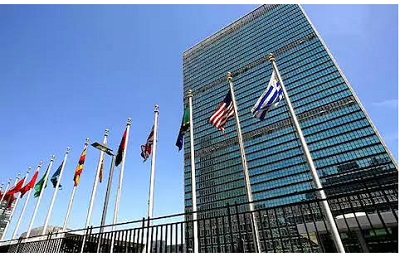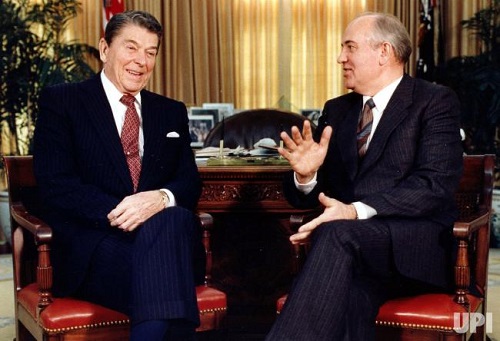United Nations
International relations refers to the cooperation of independent nations from different parts of the world politically, socially and economically.The United Nations is an association of sovereign states formed after World War II

UN Headquarters in New York - USA

The official logo/emblem of the United Nations
Reasons for Formation of UN
- To maintain international peace and security
- To replace the league of nations which had collapsed
- To promote social progress and better living standards of the people
- To promote respect for fundamental human rights and freedoms
- To promote economic growth as the member states work to reconstruct the world economy
- Cooperate in solving international social cultural and humanitarian problems
Organisation of the UN
In order to achive the organization's objectives, the UN has principal organs contained in its charter as follows;- The General Assembly: It comprises of all member states and occupies a key position in the functions of the UN.
- The Member States: There has been a steday rise of membership since 1945. there were 127 members in 1970, and that had risen to 187 in the year 2000. Today, the Un has 195 members.
- Security Council: This is composed of 15 nations which consist of five permanent states/nations which include; USA, Russia, France, China, and United Kingdom. There are ten other non-permanent members elected every two years by the general assmebly.
- International Court of Justice: This is the organ responsible for all the legal matters and disputes between member states. It is based at The Hague, Netherlands
- Economic and Social Council: It deals with matters pertaining to economic development, health and education. It works through various specialized UN agencies eg ILO, the WHO.
- The Secretariat: This is the chief administrative organ of the UN headed by a Secretary General. So far, UN has had 9 Secretaries General as follows
- Trygve Lie - Norway - 1946 to 1953
- Dag Hammarskjold - Sweden - 1953 to 1961
- U Thant - Burma - 1961 to 1971
- Kurt Waldheim - Austria - 1971 to 1981
- Javier Perez de Cuellar - Peru - 1982 to 1992
- Boutros Boutros Ghali - Egypt - 1992 to 1997
- Kofi Annan - Ghana - 1997 to 2006
- Ban Ki-Moon - South Korea - 2007 to 2016
- António Guterres - Portugal - 2016 to present
- The Trusteeship Council: It is in charge of territories which are governed by member states of the UN on behalf of the UN itself
- Human Rights Council: In December 1948, Un General Assembly adopted universal declaration of Human Rights that spells out the universal rights and freedoms entitled to an individual. There are several bodies or organisations affiliated to the UN that are involved in the fight for human rights as follows;
- Transparency Internatioanl (TI)
- Amnesty International
- United Nations High Commission on Human Rights (UNHCHR)
- United Nations High Commission of Refugees (UNHCR)
- United Nations Children Education Fund (UNICEF)
- International labour Organisation (ILO)
- Convention on Rights of Children
Performance of UN
Some of the achievements gained by the United Nations include;- Solved disputes between Nations eg India and Pakistan in 1949
- Decolonization of the third world eg Tanzania and Togo
- Championed the rights of all people world wide
- Combating diseases and training medical personnel through WHO
- Assisting refugees and other displaced people worldwide
- Initiated successful development programs in the third world countries through UNDP
- Helped to improve working conditions through ILO
- The World Food Program (WFP) has been involved in the distribution of relief food supplies to disaster victims
Challenges Facing the UN
- Ideological differences eg. Communism and capitalism.
- Shortage of funds: member states fail to remit their contributions.
- Lack of military machinery to enforce peace.
- Deep rooted regional conflicts such as Arab-Israel conflicts. v. Derailment of decision making by the VETO powers
- Lack of commitment among member states due to their interest in other organizations
- Member states acting contrary to the decision of the UNO. UN Peace keeping force
The Cold War
The Cold War refers to the rivalry that developed between USA and her allies on one hand, and the USSR and her allies on the other hand after the end of the second world war.Ronald Reagan and Mikhail Gorbachev were the leaders of USA and USSR at the height of Cold War

Ronald Reagan of USA and Mikhail Gorbachev of USSR
Methods Used in the Cold War
- Words
- Propaganda
- Economic sanctions
- Financing of political parties
- New inventions in weapons
Causes of the Cold War
- Mistrust and suspicion based on ideological differences between the capitalist west and the communist soviet bloc
- The disagreement between the USA and USSR over the issue of disarmament caused tension between them
- The policy adopted by the USSR to seal Eastern Europe from the west
- Conflicts in Europe in 1940's, for example the civil war in Greece increased tension between the two super powers
- The formation of military alliances by the two power blocs
- The Marshall plan of 1947 which was initiated by the USA intensified the cold war
Cold War in Europe
- The cold war was felt in Europe in 1947 when the USA issued the Truman Doctrine to check the spread of communism in Greece and Turkey
- The Marshall plan was initiated by the USA to help the post war Europe to recover economically from the effects of the second world war
- USSR rejected the Marshall plan and sealed off Berlin
- As a result, German was divided into two: East Germany controlled by the USSR and West Germany under the allied powers.
- Later the war intensified with the formation of military alliances namely North Atlantic Treaty Organization (NATO) and the Warsaw pact for the communist powers
- In 1961, the Berlin wall was constructed by USSR to separate the West from the East.
Cold War in Asia
- In Asia, the USSR helped to install a communist government in china in 1949
- Both powers, USA and USSR clashed over Vietnam. This led to the division of Vietnam into to two: The north controlled by the USSR, The south controlled by the USA
Cold War in Central America
- Cuba became a communist state in 1959 under Fidel Castrol
- USSR supported Cuba by arming her with dangerous missiles
- In 1962, USA ordered a blockade of Cuba and demanded USSR to stop military build up in Cuba. Factors that Led to the end of the Cold war
Factors thet Led to the End of the Cold War
- The coming to power of Khrushchev in USSR in 1956 who favored a policy of peaceful co existent
- Convening of disarmament conferences for example Strategic Arms limitation treaty of 1986 and 1991
- Establishment of Western democracies in former USSR's controlled states in Eastern Europe
- US president Ronald Reagan policy helped to diffuse tension during the cold war.
- Accession to power of Mikhail Gorbachev in the soviet union in 1985 who adopted a liberal policy
- Cancellation of Warsaw pact in 1991controlled areas in Eastern Europe.
- Disintegration of the USSR into separate republics in 1991
Effects of the Cold War
At the end of the Cold War, the world was affected in different ways as follows;- It led to splitting up of countries for example Korea onto North and South
- It caused suspicion and mistrust between nations
- It led to international insecurity and disruption of world peace
- It led to space race between USA and USSR
- It led to real war in certain situations, for example Korea and Vietnam
